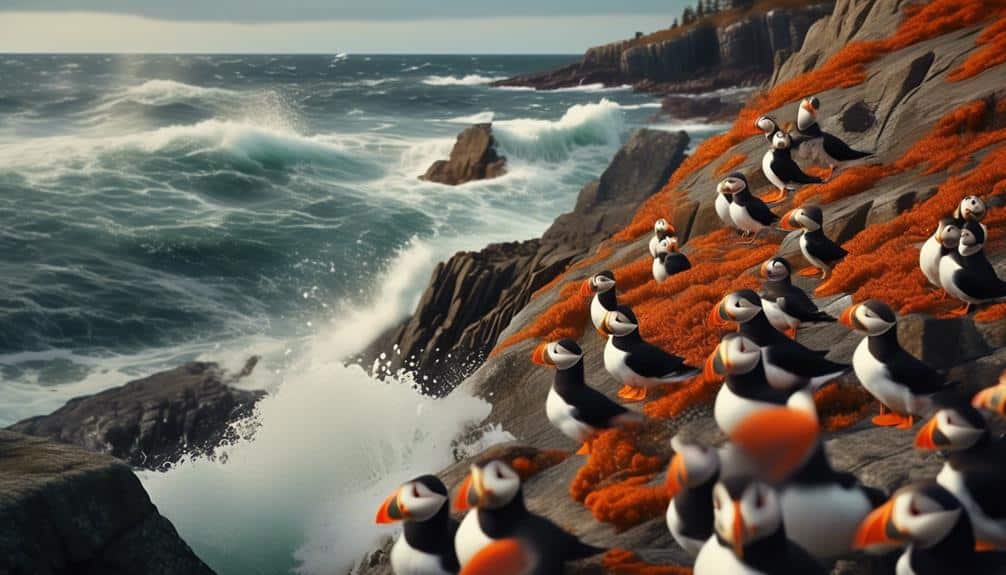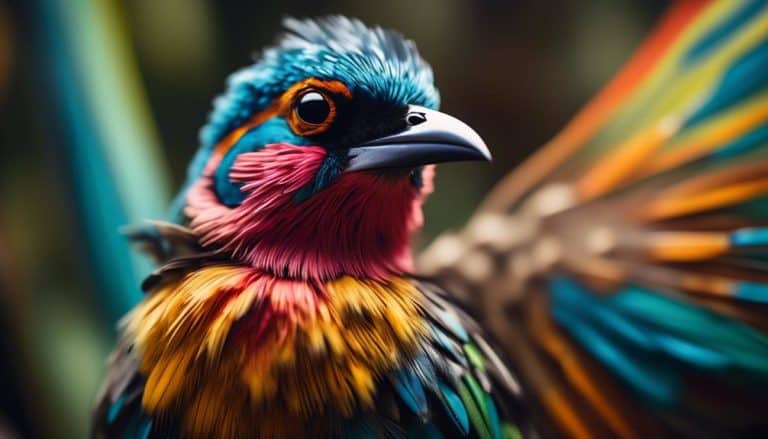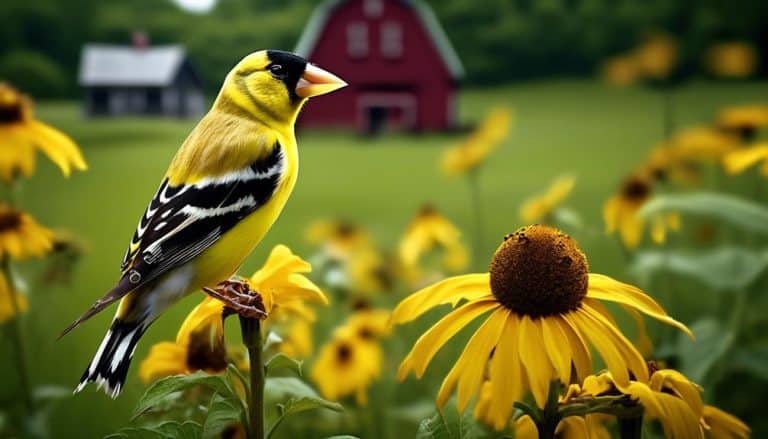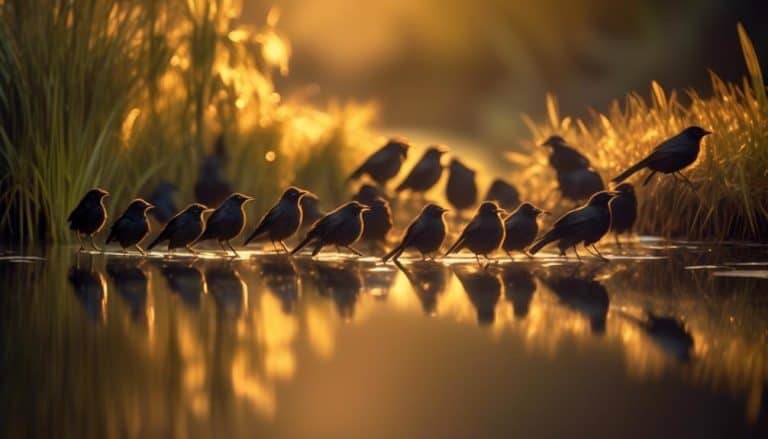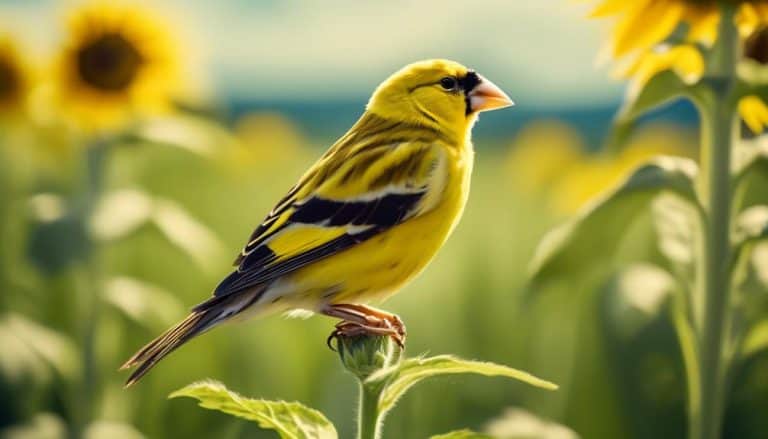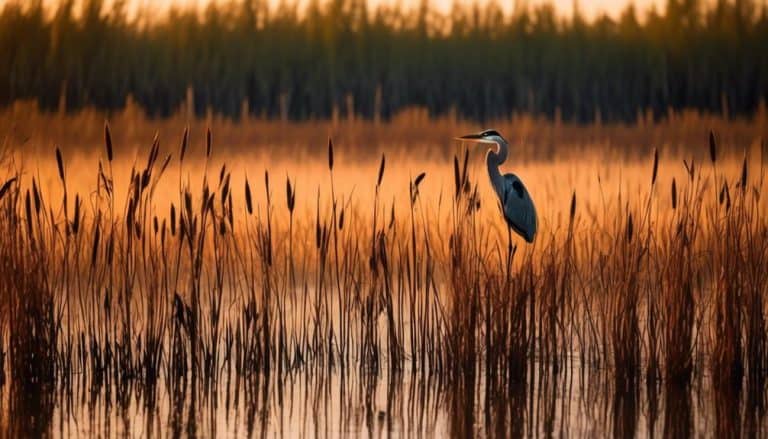When it comes to the diverse avian inhabitants of Maine's coastal regions, there is no shortage of fascinating species to observe and appreciate. From the vibrant Atlantic Puffins to the majestic Bald Eagles, these sea birds play an integral role in the delicate ecosystem of the state.
As I embark on this exploration, I find myself intrigued by the secret lives and unique characteristics of these remarkable creatures, eager to uncover the hidden depths of their existence.
Atlantic Puffins: Maine's Colorful Coastal Residents
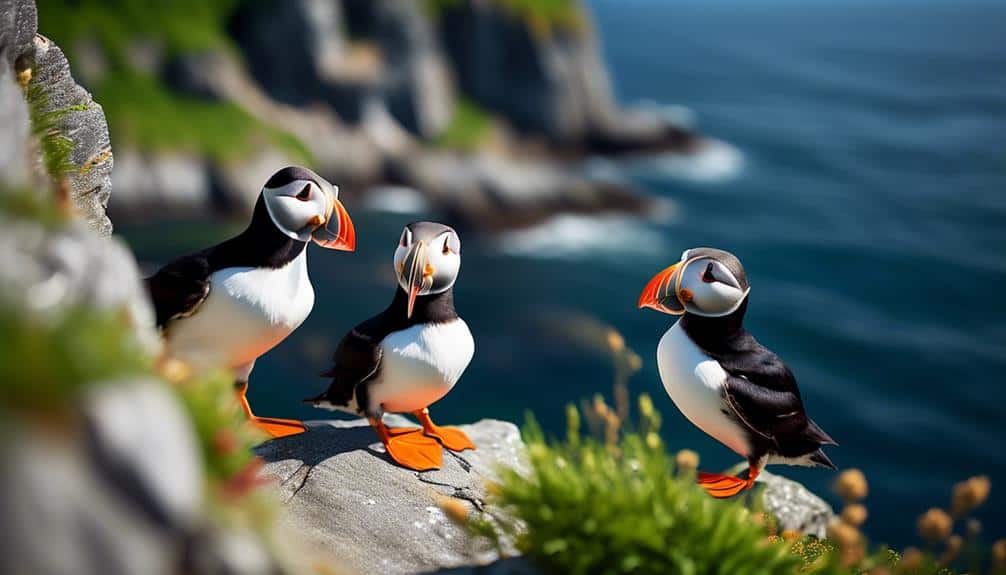
Atlantic Puffins, with their vibrant beaks and charming appearance, are the colorful coastal residents that grace the shores of Maine. These unique seabirds are a pivotal part of the ecosystem and have garnered much attention in recent years due to their conservation status. Puffin conservation efforts in Maine have aimed to protect and restore their nesting habitats, as well as monitor their population trends.
Puffins exhibit interesting nesting behavior, with colonies forming on remote islands along the coast. They typically nest in burrows or rocky crevices, providing protection from predators and the harsh elements. Puffins are known to be monogamous, returning to the same nesting site and often their same partner year after year.
To promote puffin conservation, researchers and conservationists have focused on studying their nesting behavior, breeding success, and population dynamics. Monitoring these factors allows for the identification of potential threats and the development of targeted conservation strategies. By preserving their nesting habitats and reducing disturbance from human activities, we can ensure the long-term survival of these charismatic seabirds.
Understanding puffin nesting behavior is crucial for their conservation efforts. By studying their breeding patterns, researchers can better assess the success of the population and develop effective management plans. The conservation of Atlantic Puffins in Maine requires a comprehensive approach that addresses the nesting needs of these birds while also considering the broader ecosystem dynamics. Through continued research and conservation efforts, we can help secure a future for these vibrant coastal residents.
Bald Eagles: Majestic Predators of the Sea
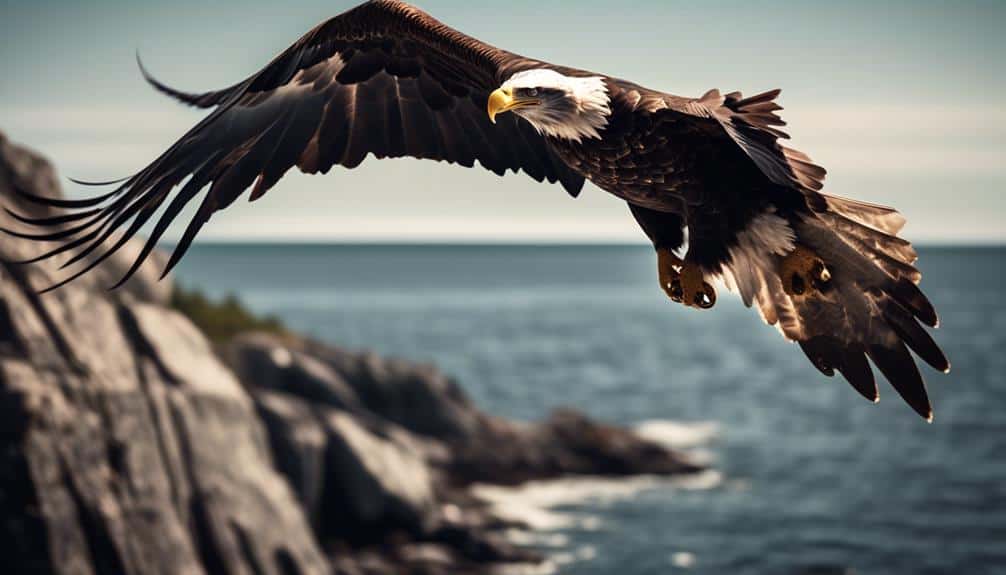
Having explored the nesting behavior and conservation efforts of Atlantic Puffins in Maine, it's now time to turn our attention to another remarkable species that's an integral part of the coastal ecosystem: the majestic Bald Eagles, formidable predators of the sea.
- The bald eagle population in Maine has experienced a significant growth in recent years, thanks to successful conservation efforts.
- Conservation organizations have focused on protecting the eagle's habitat, including nesting sites along the coast.
- Efforts to reduce pollution and protect fish populations, a crucial food source for bald eagles, have also contributed to their population growth.
Bald eagle conservation has been a priority for many organizations, recognizing the importance of this species in maintaining the balance of the coastal ecosystem. As top predators, bald eagles play a crucial role in controlling populations of fish and other prey species, ensuring a healthy and diverse marine environment.
The increase in bald eagle population is a testament to the effectiveness of conservation efforts. By protecting their habitat and food sources, we've provided a favorable environment for these magnificent birds to thrive. However, continued efforts are necessary to ensure the long-term survival of the bald eagle population in Maine.
Common Terns: Aerial Acrobats of Maine's Shores
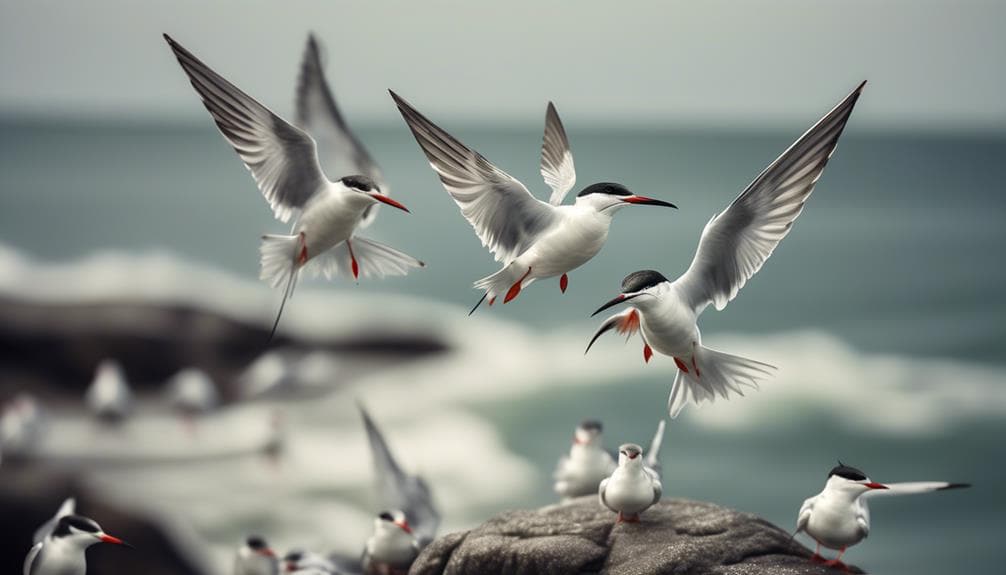
Common Terns, known as the aerial acrobats of Maine's shores, showcase their remarkable agility and grace as they navigate the coastal skies. These birds have adapted intricate aerial hunting techniques that enable them to catch their prey with astonishing precision. With their long, pointed wings and forked tails, Common Terns are built for speed and maneuverability.
When hunting, Common Terns perform impressive aerial dives, plunging headfirst into the water to catch small fish near the surface. Their sharp eyesight allows them to spot their prey from great heights, and they use their streamlined bodies to swiftly dive into the water. This aerial hunting technique is a testament to their extraordinary adaptability and hunting prowess.
In addition to their aerial hunting skills, Common Terns have interesting nesting habits. They typically nest in colonies on sandy beaches, where they build shallow depressions in the sand. The females lay their eggs in these nests, which are incubated by both parents. The nests are often carefully camouflaged, blending in with the surrounding sand to protect the vulnerable eggs from potential predators.
Common Terns are fascinating creatures that have mastered the art of aerial hunting and evolved unique nesting behaviors. Their ability to soar through the sky with agility and grace is truly awe-inspiring. As I observe these remarkable birds in action along Maine's shores, I'm reminded of the beauty and intricacy of nature's design.
Great Black-backed Gulls: Coastal Scavengers and Predators
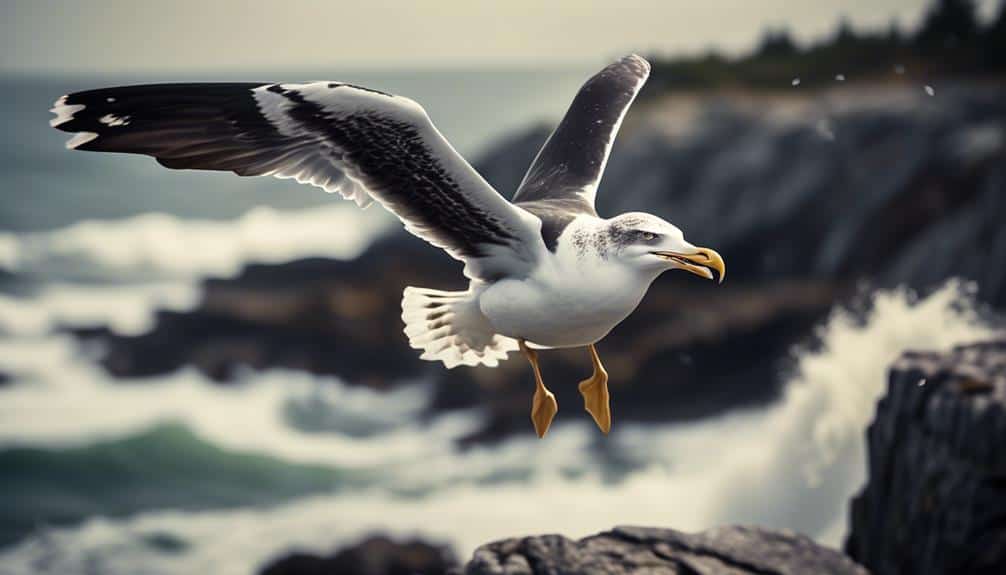
As I observe the aerial acrobats of Maine's shores, the Common Terns, it's impossible to ignore the formidable presence of the Great Black-backed Gulls, coastal scavengers and predators. These majestic birds, with their dark plumage and intimidating size, play a crucial role in the coastal food chain.
Here are some fascinating facts about Great Black-backed Gulls and their scavenging behaviors:
- Versatile Diet: Great Black-backed Gulls are opportunistic feeders, capable of consuming a wide range of prey. They're known to scavenge on dead fish, seals, and even other seabirds. Their powerful beaks allow them to tear through tough flesh, making them efficient predators in coastal ecosystems.
- Intelligence and Adaptability: These gulls demonstrate remarkable problem-solving skills and are quick learners. They've been observed using various techniques to access food sources, such as dropping hard-shelled prey onto rocks to break them open. Their ability to adapt to changing environments and food availability contributes to their success as coastal scavengers.
In the coastal food chain, Great Black-backed Gulls occupy a significant niche as both scavengers and predators. Their scavenging behaviors ensure that no resources go to waste, while their predatory nature helps control populations of smaller birds and marine creatures.
With their commanding presence and impressive foraging abilities, Great Black-backed Gulls are a vital component of Maine's coastal ecosystem.
Arctic Terns: Migratory Champions of the Atlantic
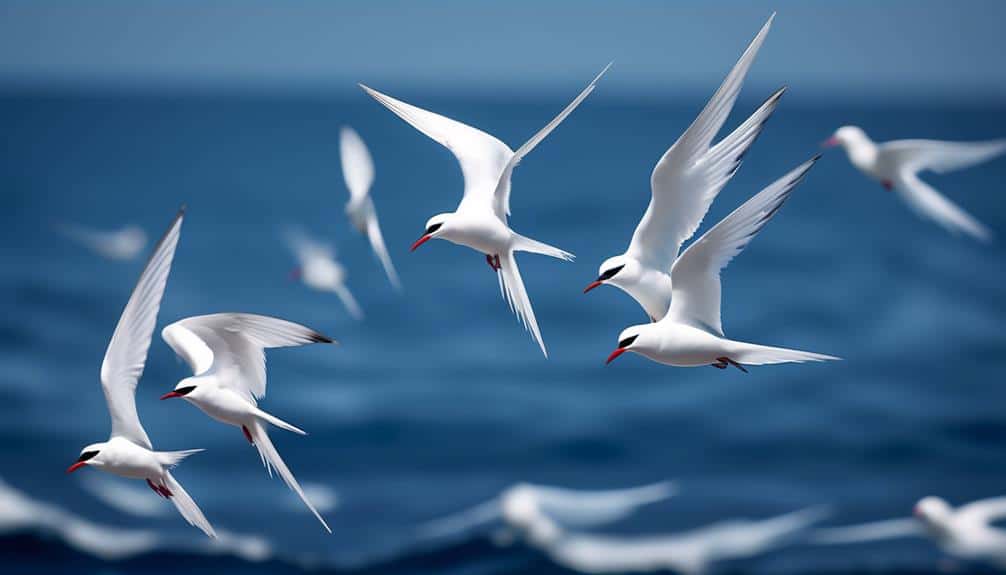
Arctic Terns, renowned for their extraordinary migratory feats, dominate the Atlantic with their impressive endurance and navigation skills. These magnificent birds undertake one of the longest migrations in the animal kingdom, traveling an astonishing 44,000 miles round-trip from their Arctic breeding grounds to their wintering grounds in the Antarctic. Their migratory patterns are truly remarkable, as they follow a zigzagging route that takes them across the Atlantic Ocean.
During the summer breeding season, Arctic Terns create nesting colonies along the coastlines of Maine, where they establish their nests on rocky islands or sandy beaches. They are highly territorial and fiercely defend their nests from intruders, using their sharp beaks and agile flight maneuvers. The presence of predators, such as gulls and foxes, poses a constant threat to their nesting habitats. To protect their offspring, Arctic Terns engage in elaborate distraction displays, feigning injury to draw attention away from their nests.
To emphasize the incredible journey of Arctic Terns, I have created a table showcasing some key facts about their migratory patterns and nesting habits:
| Migratory Patterns | Nesting Habits |
|---|---|
| Longest migration in animal kingdom | Nest in colonies along coastlines |
| Travel 44,000 miles round-trip | Establish nests on rocky islands or sandy beaches |
| Follow a zigzagging route across the Atlantic | Fiercely defend nests from predators |
| Breed in the Arctic, winter in the Antarctic | Engage in distraction displays to protect offspring |
Arctic Terns' ability to navigate across vast oceans and their dedication to protecting their nests make them true champions of the Atlantic.
Frequently Asked Questions
How Long Do Atlantic Puffins Typically Live?
Atlantic puffins typically live for about 20 years. They have a fascinating breeding pattern, with pairs returning to the same nesting site each year. Puffins are monogamous and produce a single egg per breeding season.
What Is the Average Wingspan of a Bald Eagle?
The average wingspan of a bald eagle is approximately 6 to 7 feet. These majestic birds have impressive flight capabilities due to their large wingspan, allowing them to soar through the skies with grace and power.
Do Common Terns Migrate During the Winter Months?
Yes, common terns do migrate during the winter months. It is fascinating to observe their migratory patterns as they travel long distances to find warmer climates. This behavior is crucial for their breeding success.
How Do Great Black-Backed Gulls Scavenge for Food Along the Coast?
Great black-backed gulls, known for their scavenging behavior, have impressive feeding adaptations. Along the coast, they use their large size and strong beaks to steal food from other birds and even snatch fish straight from the water.
What Is the Distance of the Arctic Tern's Annual Migration Route?
The Arctic tern's annual migration route covers an astonishing distance of over 44,000 miles, making it the longest migration of any bird. Sadly, climate change poses a threat to the tern's journey and survival.
Conclusion
In conclusion, Maine's sea birds are truly remarkable creatures, with each species playing a unique role in the coastal ecosystem.
Despite their vibrant colors and graceful flight, Atlantic Puffins, Bald Eagles, Common Terns, Great Black-backed Gulls, and Arctic Terns have mastered the art of survival in their own distinctive ways.
It's fascinating to observe these birds as they navigate the challenges of coastal life, reminding us of the delicate balance between beauty and the harsh realities of nature.

